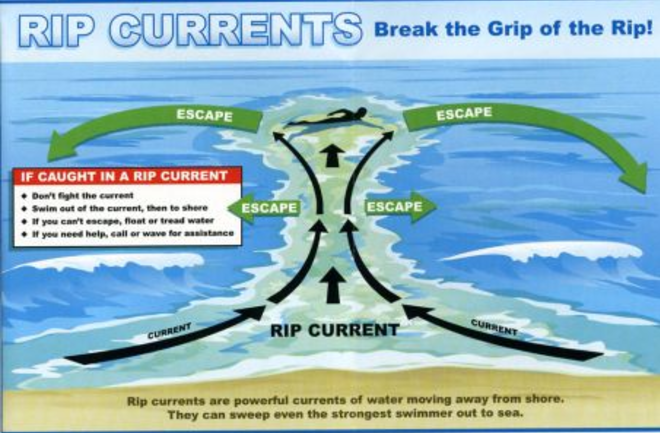Beach Safety
Ocean Safety
- During dangerous surf conditions, red "No Swimming" flags fly at beach entrances. Whenever red flags are flying, swimming is prohibited. At such times, ocean conditions have been determined to be unsafe, and swimmers are at serious risk of injury or death if they enter the water. For your safety, please heed all red flag warnings.
- Stay alert to common beach hazards. Rip currents, submerged objects, sand bar drop-offs, and jellyfish are just some hazards that you could encounter. Keep an eye on family and friends, including children.
- Be aware of your surroundings before you enter the water. Avoid swimming near fishing piers and in areas where people are fishing, avoid areas where schools of fish are active, don’t wear or take jewelry or shiny objects into the water, and stay out of the water if you are bleeding or have open sores.
- It is strongly recommended that all kayakers wear life jackets.
- All surfers must be tethered to their boards.
- Kitty Hawk, Kill Devil Hills, Southern Shores, Duck, and Corolla (including the 4x4 beaches) do not allow personal motorized watercraft (PWC) on the ocean. Nags Head allows PWCs on the ocean; however, PWC launch restrictions apply. Please contact the town of Nags Head at (252) 441-5508 for more details.
Rip Currents
Rip currents are fast-moving currents of water that can quickly pull even the strongest swimmers away from the shore. Since the current flows underwater, it’s important to know the signs of a rip current and avoid the water in that area.
According to the National Oceanic and Atmospheric Administration (NOAA), indicators of rip currents include:
- A channel of churning, choppy water.
- Notable differences in water color.
- Lines of foam, seaweed, or debris moving steadily seaward.
- A break in the incoming wave pattern.
- Be sure to read lifeguard stand signs when arriving at the beach. If you see warning signs of rip currents or moderate (yellow) or high hazard (red) flags, stay out of the water and alert others to do the same.
- If caught in a rip current, you should stay calm to conserve energy. Don’t try to fight the current. Instead, swim with the current, and swim toward shore once you’re out of the current.

General Beach Safety
- Before choosing your spot on the beach, check to be sure you will not hinder the performance of lifeguards during an emergency situation. Maintain a clear path along the dune line for patrol units and in front of stationary lifeguard stands.
- Refill all holes dug in the sand before leaving the beach area. Open holes are a safety concern for emergency response vehicles.
- Tents and personal items left on the beach overnight and should not obstruct traffic or pedestrian movement during the day. They should be removed by 5:00 pm in Southern Shores, by 7:00 pm in Duck, Kill Devil Hills, and Nags Head, and by sunset in Corolla and the 4x4 area. Personal items must be removed daily, or they may be removed as litter. Unattended items that have been removed will not be returned.
- All dunes are off-limits. The dunes are home to nesting turtles and vegetation specific to our area. Additionally, dunes protect homes from flooding during a storm surge.
- Do not leave trash on the beach.
- Beach bonfires are strictly prohibited in Kitty Hawk, Kill Devil Hills, Southern Shores, Duck, and Corolla (including the 4x4 beaches). Beach pit fires are allowed on the beach in Nags Head with a permit. For more information, contact Nags Head Fire and Rescue at (252) 441-5909.
- ATVs are not permitted for non-residents.
- Fireworks are strictly prohibited on the Outer Banks.
- It is illegal to launch sky lanterns, commonly known as Chinese lanterns, on the 4x4 beaches, in Corolla, Duck, Southern Shores, Kitty Hawk, Kill Devil Hills, or Nags Head.